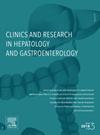戈谢病I型的多器官纤维化:酶替代治疗尚未实现的目标。
IF 2.4
4区 医学
Q2 GASTROENTEROLOGY & HEPATOLOGY
Clinics and research in hepatology and gastroenterology
Pub Date : 2025-09-01
DOI:10.1016/j.clinre.2025.102677
引用次数: 0
摘要
戈谢病(GD)是最常见的溶酶体贮积性疾病,其特征是巨噬细胞内葡糖脑苷积累,导致多系统受累,包括器官肿大、细胞减少和骨病。本研究旨在通过瞬时弹性成像(FibroScan®)评估GD1患者肝、脾和骨髓(BM)纤维化的存在和程度。分析26例成人GD1患者,分别采用treatment-naïve和酶替代疗法(ERT)治疗,评估肝脏和脾脏僵硬度。8例持续性细胞减少伴肝脾肿大患者行骨髓活检。肝脏和脾脏中位刚度分别为4.8 kPa和26 kPa。77%的患者发现轻度肝纤维化,15%的患者发现中度肝纤维化,7.7%的患者发现肝硬化,naïve组和治疗组之间的患病率相当。54%的患者出现脾纤维化,在接受ERT治疗的患者中更为常见。肝纤维化和脾纤维化之间以及器官僵硬和纤维化严重程度之间存在很强的相关性。75%的活检患者发现骨髓纤维化。这些发现表明,尽管ERT,纤维化进展可能持续存在,而且不局限于肝脏。将非侵入性纤维化评估纳入常规GD1监测可能改善这种疾病并发症的早期发现和管理。本文章由计算机程序翻译,如有差异,请以英文原文为准。
Multiorgan fibrosis in Gaucher disease type I: an unmet goal of enzyme replacement therapy
Gaucher disease (GD), the most common lysosomal storage disorders, is characterized by glucocerebroside accumulation within macrophages, leading to multisystem involvement including organomegaly, cytopenias, and bone disease. This study aimed to assess the presence and extent of hepatic, splenic, and bone marrow (BM) fibrosis in GD1 patients by using transient elastography (FibroScan®). Analysis a series of 26 adult GD1 patients, both treatment-naïve and enzyme replacement therapy (ERT) treated, was evaluated for liver and spleen stiffness. Eight patients with persistent cytopenia and hepatosplenomegaly underwent BM biopsy. Median liver and spleen stiffness were 4.8 kPa and 26 kPa, respectively. Mild liver fibrosis was identified in 77% of patients, moderate fibrosis in 15%, and cirrhosis in 7.7%, with comparable prevalence between naïve and treated groups. Splenic fibrosis was observed in 54% of patients, more frequently among those receiving ERT. A strong correlation was found between hepatic and splenic fibrosis, as well as between organ stiffness and fibrosis severity. Bone marrow fibrosis was detected in 75% of biopsied patients. These findings indicate that fibrotic progression may persist despite ERT and is not limited to the liver. Integrating non-invasive fibrosis assessment into routine GD1 monitoring may improve early detection and management of this disease complications.
求助全文
通过发布文献求助,成功后即可免费获取论文全文。
去求助
来源期刊

Clinics and research in hepatology and gastroenterology
GASTROENTEROLOGY & HEPATOLOGY-
CiteScore
4.30
自引率
3.70%
发文量
198
审稿时长
42 days
期刊介绍:
Clinics and Research in Hepatology and Gastroenterology publishes high-quality original research papers in the field of hepatology and gastroenterology. The editors put the accent on rapid communication of new research and clinical developments and so called "hot topic" issues. Following a clear Editorial line, besides original articles and case reports, each issue features editorials, commentaries and reviews. The journal encourages research and discussion between all those involved in the specialty on an international level. All articles are peer reviewed by international experts, the articles in press are online and indexed in the international databases (Current Contents, Pubmed, Scopus, Science Direct).
Clinics and Research in Hepatology and Gastroenterology is a subscription journal (with optional open access), which allows you to publish your research without any cost to you (unless you proactively chose the open access option). Your article will be available to all researchers around the globe whose institution has a subscription to the journal.
 求助内容:
求助内容: 应助结果提醒方式:
应助结果提醒方式:


